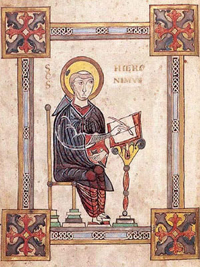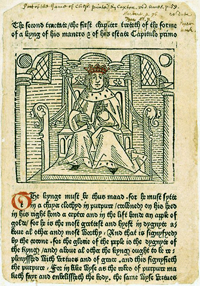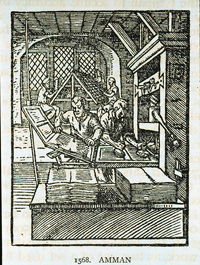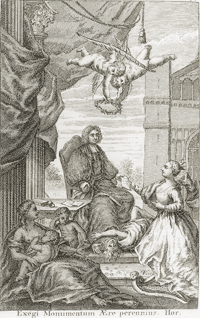Schedule (Fall & Winter 2009–2010)
SECTION 1. Introduction |
|
F Sept 4 |
Introduction to the History & Future of the Book |
| M Sept 7 | Labour Day: No class |
W Sept 9 |
Discussion: What does "the book" mean to our culture? This isn't required reading, but this article from the Boston Globe will likely come up today: administrators at Cushing Academy in New England have have decided to discard all their books: "'When I look at books, I see an outdated technology, like scrolls before books,' said James Tracy, headmaster of Cushing and chief promoter of the bookless campus." |
F Sept 11 |
Lecture: "The Shape of the Book" |
M Sept 14 |
The Shape of New Media
|
W Sept 16 |
The Effects of Media
|
F Sept 18 |
Memory, Wisdom, Consciousness and the Technologies of Writing 1
Not required reading, but I've just discovered a recent post by Kevin Kelly (co-founder of Wired magazine), which does a terrific job of re-presenting the issues from a decade ago from both sides, along with commentary on the current debate with Carr: The Fate of the Book. |
M Sept 21 |
Memory, Wisdom, Consciousness and the Technologies of Writing 2
|
SECTION 2. Understanding new forms of digital literature: Electronic Poetry, Web 2.0, DRM |
|
W Sept 23 |
Electronic Poetry I
This is not required reading but you might find it interesting to compare the e-text above with a pdf of the book version of Soliloquy. |
F Sept 25 |
Electronic Poetry II
As described by the Electronic Literature Organization: "Originally published in 1992, AGRIPPA (A BOOK OF THE DEAD) was a limited edition art book that contained double-column pages of DNA code laid out to allude to the Gutenberg Bible, copperplate aquatint etchings by Dennis Ashbaugh alluding to DNA gel patterns (some overprinted with antique newspaper advertisements of technological artifacts), and a "disappearing" poem about memory, family, youth, and mechanisms by William Gibson (on a read-once-only, self-encrypting diskette). During the rise of the Internet and Web in the early 1990s, the poem and book were read as marking a symbolic transition from the codex book to digital media. But in all this time, the physical book itself has rarely been seen." |
M Sept 28 |
Agrippa (a book of the dead) cont'd |
W Sept 30 |
Electronic Poetry III YOUNG-HAE CHANG HEAVY INDUSTRIES |
F Oct 2 |
YOUNG-HAE CHANG HEAVY INDUSTRIES cont'd |
M Oct 5 |
Penguin's Foray into Digital Publishing
|
W Oct 7 |
|
F Oct 9 |
Essay #1 Due Web 2.0 Introduction, or What's this "Web 2.0"? And what's it doing in my English Literature class?
|
| M Oct 12 | Thanksgiving Day: no class |
W Oct 14 |
Web 2.0: Blogs & Vlogs
|
F Oct 16 |
Web 2.0: Diy-broadcasting, Bittorrents
|
M Oct 19 |
Web 2.0: Social Networking & Folksonomies |
W Oct 21 |
Web 2.0: Wikis & Knowledge
|
F Oct 23 |
DRM I : Controlling Readers/Viewers |
M Oct 26 |
DRM II: Controlling Creativity
It's not required reading, but it's very interesting reading: "RIAA v. The People: Five Years Later," a report published by the Electronic Frontier Foundation (EFF) on the outcomes of five years of the recording industry suing American people. |
W Oct 28 |
DRM III: Creative Commons
|
SECTION 3. Orality |
|
F Oct 30 |
Old English Literature: From Oral (?) to Written Narrative
Some Psychodynamics of Orality (from Walter Ong's Orality and Literacy: The Technologizing of the Word) |
M Nov 2 |
Old English Literature: From Oral (?) to Written Narrative (cont'd) |
W Nov 4 |
Old English Literature: From Oral (?) to Written Narrative (cont'd) |
F Nov 6 |
Old English Literature: From Oral (?) to Written Narrative (cont'd) |
|
SECTION 4. Manuscript Culture: Reading & writing the Medieval book |
|
M Nov 9 |
From the Scroll to the Codex Book
|
| W Nov 11 | Remembrance Day: no class |
F Nov 13 |
Making Medieval books |
M Nov 16 |
Middle English literature: lyric poetry Before we discuss these poems, we'll start with a lecture on the cultural/historical background of Medieval scribes, writing, and authorship.
Here are some notes on Lyric Poetry. |
W Nov 18 |
Middle English literature: lyric poetry cont'd |
F Nov 20 |
Middle English literature: lyric poetry cont'd |
M Nov 23 |
Essay #2 Due The Medieval Page: viewing of the Otto Ege Medieval Manuscript Collection at the U of S Library Special Collections Group one (last name A through K): go to the main library, 3rd floor |
W Nov 25 |
The Medieval Page: viewing of the Otto Ege Medieval Manuscript Collection at the U of S Library Special Collections Group two (last name L through Z): go to the main library, 3rd floor |
F Nov 27 |
Middle English literature: Chaucer's Canterbury Tales
|
M Nov 30 |
Middle English literature: Chaucer's Canterbury Tales and fabliaux
To cite this work, please cite the original edition: Chaucer, Geoffrey. “The Miller’s Tale.” The Canterbury Tales. Ed. Michael Murphy. n.d. 21 January 2008 http://academic.brooklyn.cuny.edu/webcore/
Here are the notes on Chaucer. |
W Dec 2 |
Middle English literature: Chaucer's Canterbury Tales and fabliaux (cont'd) |
F Dec 4 |
Middle English literature: Chaucer's Canterbury Tales and fabliaux (cont'd) |
Have a Great Holiday! |
|
M Jan 4 |
Research Assignment Seminar: instructions for doing your online research project. PLEASE DO NOT SKIP THESE CLASSES: THIS IS A DIFFICULT ASSIGNMENT AND YOU RISK THROWING AWAY MARKS IF YOU DO NOT UNDERSTAND HOW TO DO IT. |
W Jan 6 |
instructions for doing your online research project cont'd |
|
SECTION 5. 15th-century Print Culture: the Dawn of the "Gutenberg Era" and the Rise of Humanism |
|
F Jan 8 |
Gutenberg, the Bible & the rise of the English language
if you're interested: the British Library's beautiful facsimiles of the first two Bibles printed by Gutenberg |
M Jan 11 |
Elizabeth Eisenstein, "The Emergence of Print culture in the West" [RP] |
W Jan 13 |
The Book and English Nationalism: William Caxton's Editions of Chaucer
|
|
SECTION 6. The 16th & 17th Centuries: Renaissance Print Culture |
|
F Jan 15 |
16th-century private books & 17th-c. public books
|
M Jan 18 |
16th-century private books & 17th-c. public books (cont'd)
|
W Jan 20 |
16th-/17th-century printed books & public authors: William Shakespeare
|
F Jan 22 |
16th-/17th-century printed books & public authors: William Shakespeare (cont'd)
|
M Jan 25 |
Research Assignment due 16th-/17th-century printed books & public authors: William Shakespeare (cont'd) |
W Jan 27 |
17th-century printed books & public authors: Ben Jonson
Here's a beautiful facsimile of the first edition of Jonson's Works. Here's the title page at its largest resolution. |
F Jan 29 |
17th-century printed books & public authors: Ben Jonson |
M Feb 1 |
17th-century words in print: the carmen figuratum
|
|
SECTION 7. the 18th century: Capitalism, Novels & the Rise of Commercial Print Culture |
|
W Feb 3 |
18th-Century print culture & the rise of capitalism
|
F Feb 5 |
Control and Copyright Here's a pdf of Regulation of the press overview (Henry VIII to George I). |
M Feb 8 |
William Blake's illuminated poetry
|
W Feb 10 |
William Blake's illuminated poetry (cont'd) |
F Feb 12 |
William Blake's illuminated poetry (cont'd) |
Feb 15 - Feb 20: Midterm Break |
|
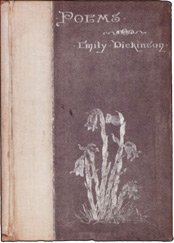
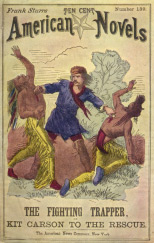
SECTION 8. 19th Century: "Romantic" vs. "Mechanic" print culture |
|
M Feb 22 |
19th century: books and knowledge/nostalgia
If you're curious to see a facsimile of the original manuscript in Keats' handwriting, be sure to see John Keats: Original Manuscript Images It's not required reading but here is the complete text of George Chapman's translation of The Odysseys of Homer (1614–16). |
W Feb 24 |
Charles Dickens and serial fiction
|
F Feb 26 |
Charles Dickens and serial fiction (cont'd) |
M Mar 1 |
Dime novels (and penny dreadfuls)
This is not required reading, but if you're in the mood for a penny dreadful, you can read Varney the Vampire; or, The Feast of Blood at the University of Virginia Library Electronic Text Center. |
W Mar 3 |
Dime novels (and penny dreadfuls) (cont'd) |
F Mar 5 |
Mark Twain™ Slides from class: Reviews of Huckleberry Finn (more on the contemporary reaction to this book is available at Stephen Railton's Mark Twain in His Times) |
M Mar 8 |
Mark Twain™ (cont'd) |
W Mar 10 |
Emily Dickinson's handmade poetry books
|
F Mar 12 |
Emily Dickinson's handmade poetry books (cont'd) |
SECTION 9. The 20th Century: Mass Culture |
|
M Mar 15 |
Essay #3 due The 20th-Century paperback phenomenon |
W Mar 17 |
Pulp fiction
|
F Mar 19 |
Pulp fiction (cont'd) |
M Mar 22 |
20th-century book clubs
|
W Mar 24 |
Mass distribution, censorship, and freedom to read
|
F Mar 26 |
The library of Babel: human knowledge at the height of book culture
|
M Mar 29 |
The library of Babel: human knowledge at the height of book culture (cont'd) |
W Mar 31 |
Secondary orality: 20th c. storytellers
|
| F Apr 2 | Good Friday: no class |
M Apr 5 |
Secondary orality: 20th c. storytellers cont'd Thomas King stories recording |
W Apr 7 |
Closure |
